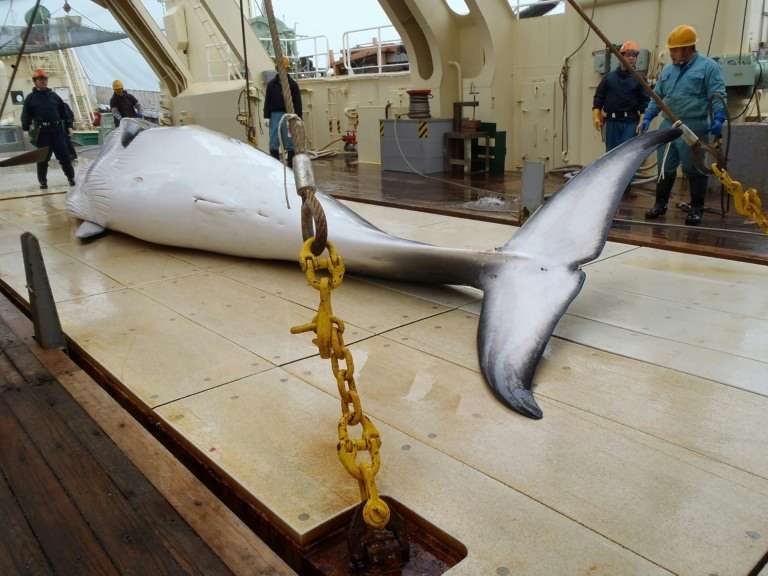FILES/AFP/File / Institute of Cetacean Research Japan is a signatory to the International Whaling Commission moratorium on hunting, but exploits a loophole that allows whales to be killed for scientific research Japanese whaling vessels returned to port on Saturday after catching more than 300 of the mammals in the Antarctic Ocean without facing any protests by anti-whaling groups, officials said. A fleet of five whalers set sail for the Southern Ocean in November, as Tokyo pursues its "research whaling" in defiance of global criticism.
Three of the vessels, including the fleet's main ship, the Nisshin Maru, arrived in the morning at Shimonoseki port in western Japan, a port official said.
The fleet caught 333 minke whales as planned without any interruption by anti-whaling campaigners, the Fisheries Agency said in a statement.
Japanese whalers have in the past clashed at sea with animal rights campaigners, particularly the Sea Shepherd activist group, which last year announced it had no plan to make offshore protests this season.
Japan is a signatory to the International Whaling Commission moratorium on hunting, but exploits a loophole that allows whales to be killed for scientific research.
Tokyo says the slaughter is necessary for in-depth knowledge of whale behaviour and biology, but it makes no secret of the fact that whales killed in the hunts often end up on dinner plates.

skyskr4per on March 31st, 2018 at 17:02 UTC »
Which countries are still whaling despite the 1986 IWC ban on commercial whaling? Japan
Almost immediately after the 1986 whaling ban came into effect, Japan launched its scientific whaling programme, widely recognised as a cover for its ongoing commercial whaling operation.
Meat from these whales — supposedly killed for science — is then sold in food markets or given away free or at low costs to schools and hospitals in marketing drives to encourage the consumption of whale meat .
The Japanese whaling fleet departs twice a year. In the North Pacific, Japanese whalers can kill up to 200 minke whales, 50 Bryde whales, 100 sei whales and 10 sperm whales under the guise of scientific research. Vessels had been killing up to 935 minke whales and 50 fin whales each year in the Southern Ocean Sanctuary before the International Court of Justice ruled that this was illegal.
NorwayNorway only respected the IWC's whaling ban until 1993. Using a loophole in the International Convention for the Regulation of Whaling, Norway objected to the whaling moratorium, and resumed hunting for minke whales.
Norway sets its own quota for the number of whales its whalers are permitted to kill for commercial reasons. This number has gone up and up, from being allowed to kill 671 minke whales in 2002 to more than 1,000 today. However, in recent years, less than half of this self-allocated catch limit has been taken.
Norway is now hunting a higher proportion of breeding females which could put the long-term survival of minke whales in the North Atlantic in severe danger.
IcelandLike Japan, Iceland initially conducted a 'scientific' whaling programme. Then, in 1992, it withdrew from the IWC. When Iceland re-joined in 2004, it included a clause in its re-entry that spoke out in objection to the whaling moratorium.
In 2006, Iceland resumed commercial whaling, targeting minke and fin whales. In 2010 alone, Icelandic whalers killed 148 endangered fin whales and 60 minke whales.
Source: Copypasta from https://www.ifaw.org/united-states/our-work/whales/which-countries-are-still-whaling
angryco1 on March 31st, 2018 at 16:41 UTC »
The world is a vampire
BenpiGeri on March 31st, 2018 at 12:21 UTC »
Funny how these posts on reddit are almost always about Japanese whalers, despite the fact that Norway is the most active whaling nation in the world, killing more whales than Japan and Iceland combined.